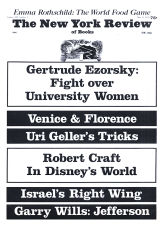I
“a…mouse came over with…the Conqueror.”
—Alice in Wonderland
“Visitors from the real world,” the Disney World receptionists say, and “real world” is a term of reference in Christopher Finch’s seven-pound book. But since Walt Disney World is a part of Florida, reality is hardly the issue. The Disney complex is simply another, albeit the ne plus ultra, Sunshine State resort. Peter Blake, who contributes a chapter on Disneyland and WDW, rates the hotel and motel architecture of the latter “considerably above Miami Beach standards.” (That is a recommendation?) No doubt, too, WDW is not only technologically newer but also physically and morally cleaner than other, amusement parks. Yet its outward aspect is no more incongruous in the Florida setting than are the derelict structures of World’s Fairs along the traffic-jammed expressway to the New York airports.
What is more, the interior of WDW is primarily a shopping center, the outstanding “magicians” in the Magic Kingdom including such familiar entertainers as Gulf Oil, Goodyear, Eastern Airlines. (“One purpose of WDW is to make money,” Blake writers, as if he were revealing a well-kept secret.) As for Fantasyland and Tomorrowland, these hold few surprises for a nation accustomed to stylistic agglomerations of the spuriously old and the sterile modern, and to stultifying model communities of the past and future. In short, the borders of the real world, as distinguished from those on maps of the Disney enclave, may well have been crossed by society as a whole and some time ago. And vis à vis this general schizophrenia, WDW is remarkable mainly as an attempt to establish an isolation ward.
The truth of Marx’s argument, that the economic life of capitalism is responsible for the secularization of society, could hardly be more blatantly evident than it is in parts of Florida. Not that this state has a corner on the theory that the greatest public good derives from the greatest private selfishness, but the attempt to prove it is certainly more concentrated and apparent here. Wherever market value is both the determinant and the criterion, indifference to aesthetic quality is inevitable, to say nothing of the disappearance of spiritual content and the alienation of the individual.
This Issue
May 16, 1974





